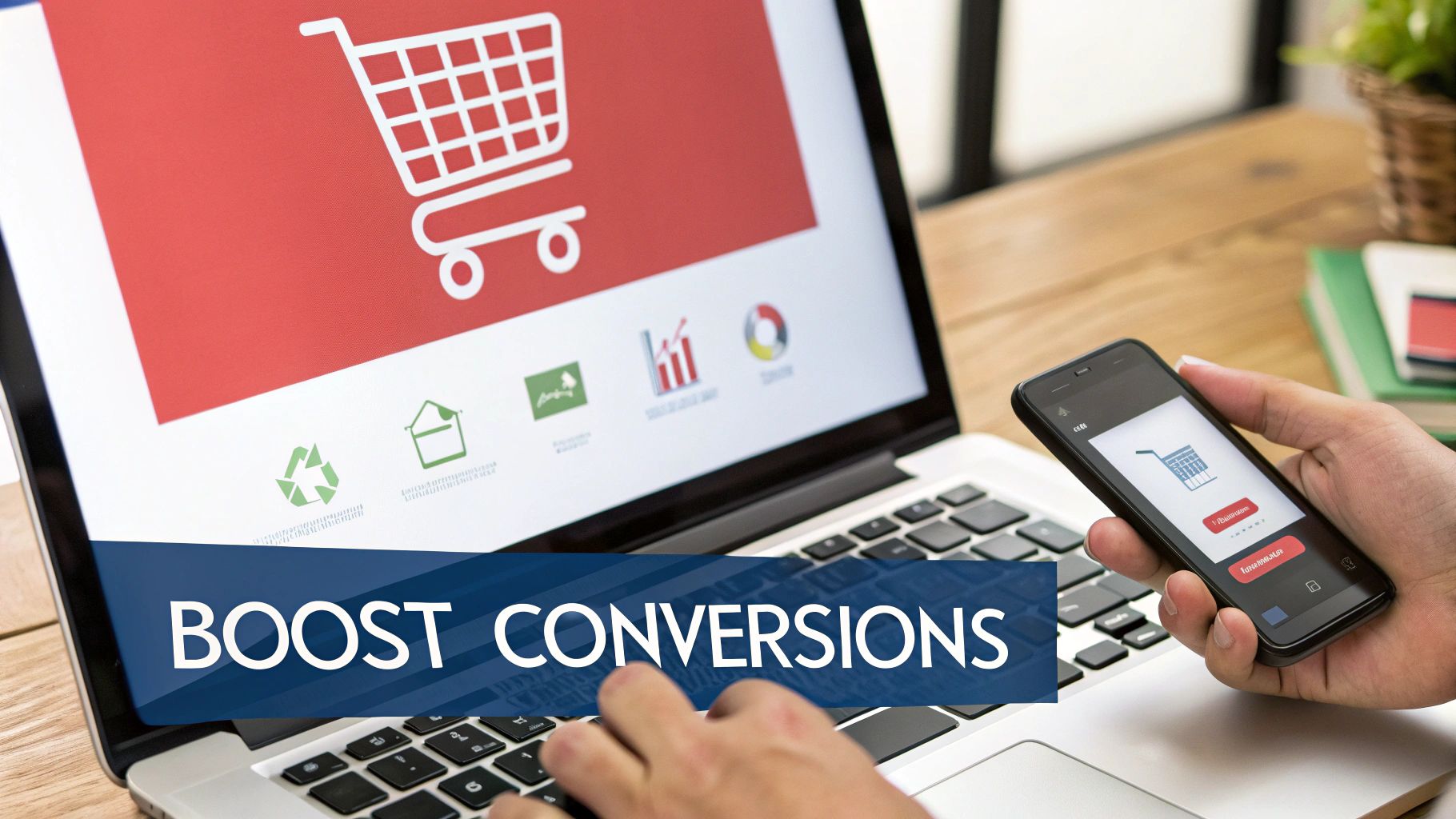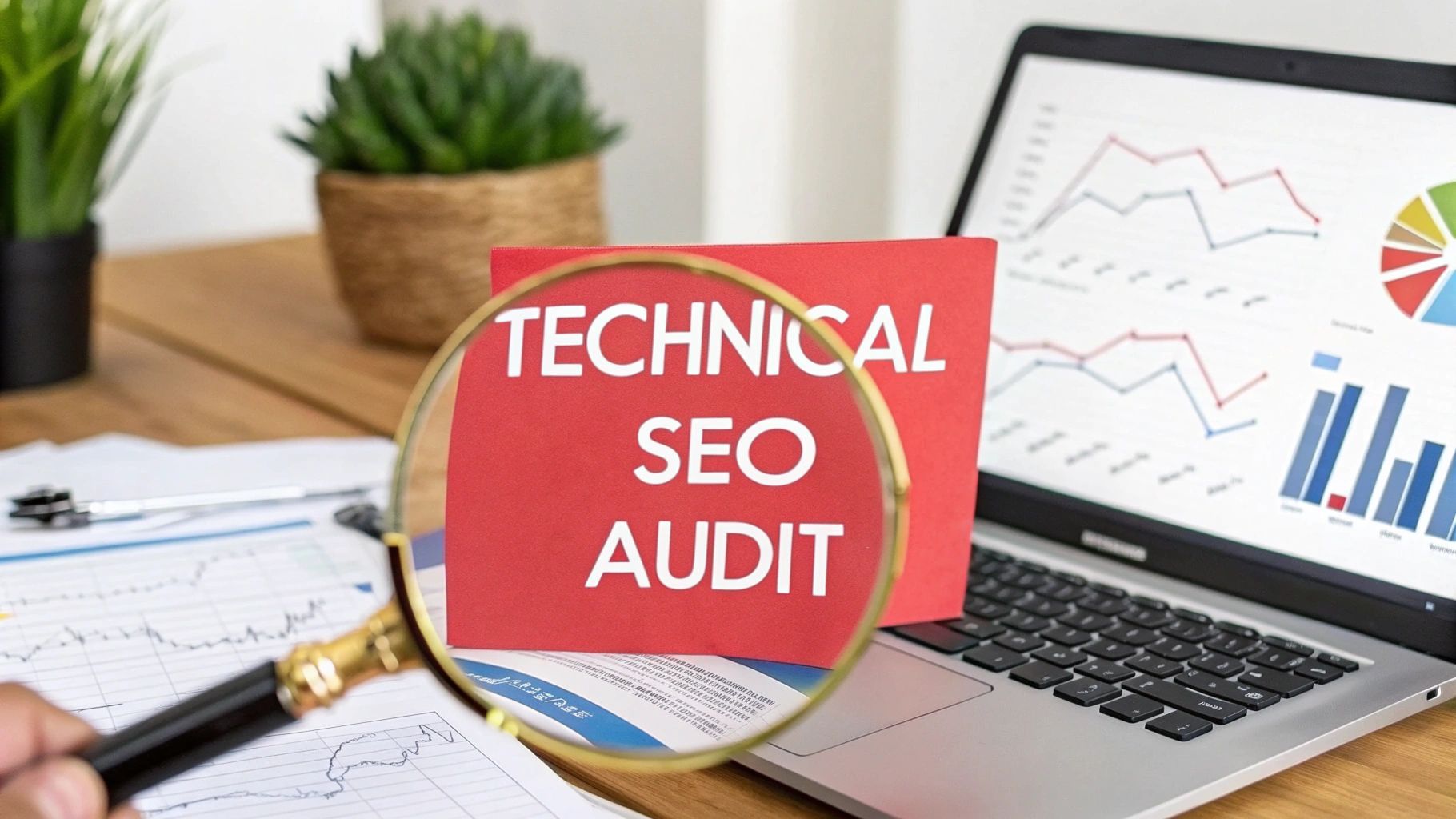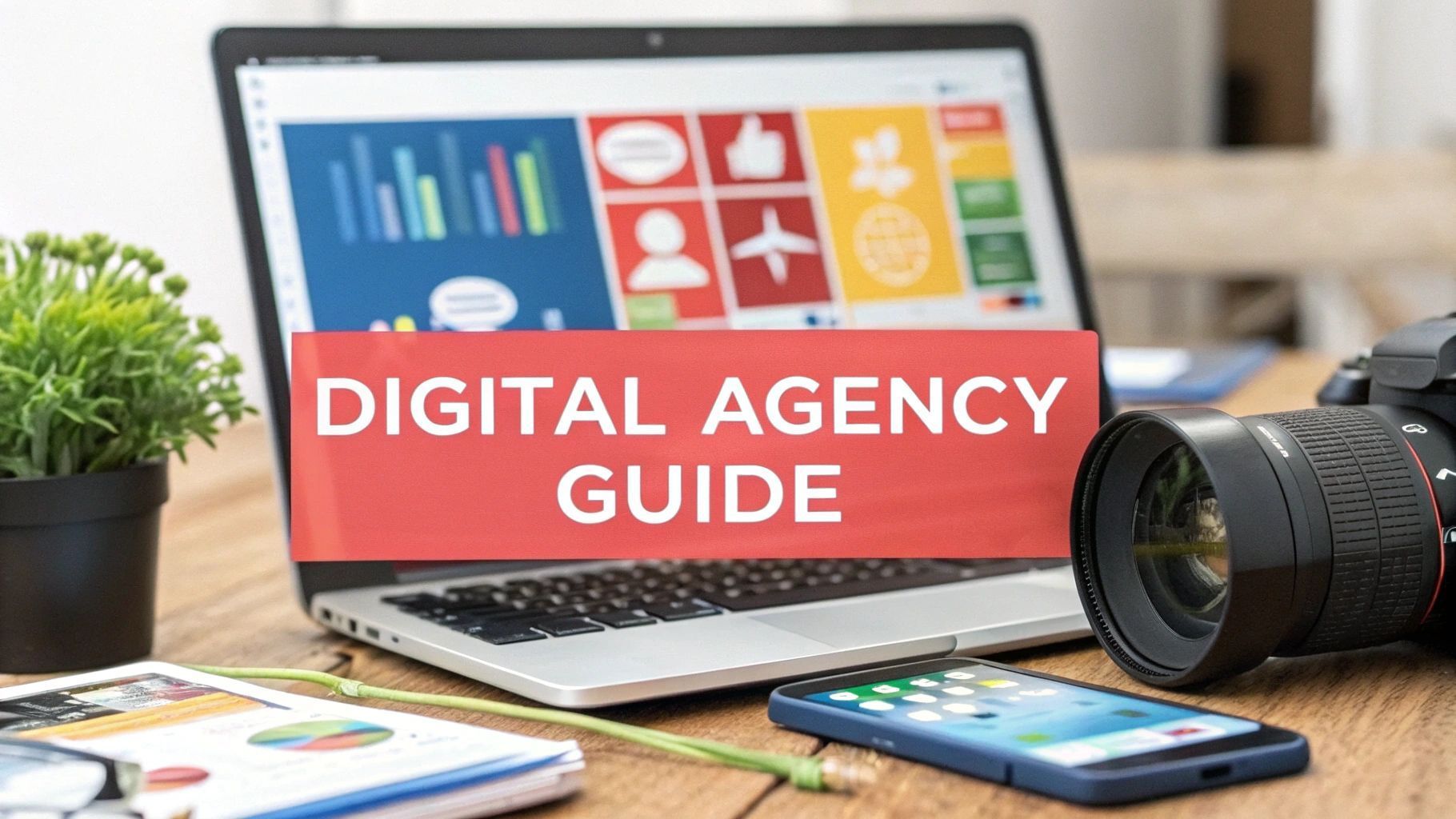10 Potent Ecommerce Growth Strategies for 2025
In the hyper-competitive digital marketplace, simply having an online store is no longer enough to guarantee success. To truly thrive, you need a robust plan built on proven ecommerce growth strategies. Standing still means falling behind but navigating the myriad of available tactics can feel overwhelming. This guide cuts through the noise, presenting ten potent, actionable strategies designed to drive meaningful results for your business.
We will explore each method in detail, moving beyond generic advice to provide practical steps, real-world examples and performance benchmarks you can use to measure your own progress. From optimising conversions on your existing traffic to pioneering new subscription revenue models, these strategies will equip you with the tools to build a more profitable and resilient online business. We'll cover everything from AI-driven personalisation and influencer marketing to advanced SEO and customer loyalty programmes.
For UK businesses aiming to scale, especially in specialised sectors like motorsport or automotive, a targeted approach is paramount. This blueprint offers a clear path forward, helping you prioritise efforts and invest resources where they will generate the greatest return. To further explore various comprehensive plans for expanding your online business, delve into insights on Top Ecommerce Growth Strategies for 2025. This article provides a structured framework, ensuring you focus on the most impactful actions to achieve sustainable growth and outpace your competition. Let’s begin.
1. Conversion Rate Optimisation (CRO)
Conversion Rate Optimisation, or CRO, is a systematic process of increasing the percentage of website visitors who take a desired action. Instead of chasing more traffic, this ecommerce growth strategy focuses on maximising the value of the traffic you already have. It involves analysing user behaviour, forming hypotheses about potential improvements and using A/B testing to validate changes that enhance the user journey and encourage conversions, such as completing a purchase or signing up for a newsletter.

The power of CRO lies in its data-driven approach. By making small, iterative changes to elements like your product page layout, checkout process or call-to-action buttons, you can achieve significant gains in revenue. For instance, global giants like Amazon continuously refine their checkout flow, reportedly boosting conversions by small but hugely impactful percentages annually. Similarly, many Shopify stores have slashed cart abandonment rates by simply removing unnecessary fields from their checkout forms.
How to Implement CRO
To get started with this essential ecommerce growth strategy, focus on methodical testing and user-centric design.
- Identify Friction Points: Use tools like heatmaps and session recordings to see where users are dropping off. Prioritise optimising high-traffic, low-converting pages first.
- Simplify the Checkout: Reduce the number of steps and form fields required to complete a purchase. Offer guest checkout options to minimise barriers.
- Test One Element at a Time: To accurately measure impact, isolate your tests. Change a button colour, headline or image but not all at once.
- Optimise for Mobile: A seamless mobile experience is non-negotiable. Ensure your site is fast, responsive and easy to navigate on smaller screens.
CRO is a continuous cycle of improvement, not a one-time fix. By consistently analysing performance and refining your website, you create a more efficient sales funnel that turns more browsers into buyers. For a deeper look into designing pages that convert, explore the anatomy of a high-converting landing page.
2. Personalisation and AI-Driven Recommendations
Personalisation is an ecommerce growth strategy that uses customer data and artificial intelligence (AI) to deliver tailored shopping experiences. Instead of a one-size-fits-all approach, it presents individual users with customised product recommendations, content and offers based on their browsing behaviour, purchase history and personal preferences. This makes the shopping journey more relevant and engaging, which directly boosts conversions and average order value.

The impact of this strategy is profound. Amazon famously attributes as much as 35% of its revenue to its recommendation engine, which powers features like "Customers who bought this also bought...". Similarly, beauty retailer Sephora uses its Virtual Artist app to provide AI-powered makeup recommendations, creating a highly personal and interactive experience that drives sales. By making customers feel understood, you build loyalty and significantly increase their lifetime value.
How to Implement Personalisation
To effectively integrate this strategy, focus on leveraging data ethically and testing different recommendation models.
- Implement Recommendation Engines: Use AI tools to add dynamic product suggestions to key areas like product pages, the shopping cart and marketing emails.
- Leverage Behavioural Data: Go beyond purchase history. Track what users view, what they add to their cart and what search terms they use to create a richer customer profile.
- Segment Your Audience: Group customers based on shared characteristics or behaviours to send targeted campaigns, such as offering a special discount to first-time visitors.
- Balance Personalisation and Privacy: Be transparent with customers about how you collect and use their data. Ensure your practices are fully compliant with regulations like GDPR.
Personalisation is no longer a luxury but an expectation. By harnessing AI, you can create a smarter, more intuitive storefront that anticipates customer needs and guides them toward a purchase. For a deeper dive into this technology, explore how artificial intelligence is revolutionising digital marketing.
3. Influencer and Affiliate Marketing Partnerships
Influencer and affiliate marketing involves leveraging relationships with content creators and partners to promote your products through authentic endorsements. Instead of traditional advertising, this ecommerce growth strategy taps into the trust and authority that influencers and affiliates have built with their audiences. It extends your brand’s reach to highly targeted communities, often on a performance-based or commission model, making it a cost-effective way to drive traffic and sales.
The power of this approach lies in social proof. When a trusted creator recommends a product, it feels more like a genuine suggestion from a friend than a corporate advertisement. Fashion Nova famously mastered this, partnering with thousands of micro-influencers to build a massive, engaged customer base and generate hundreds of millions in revenue. Similarly, the Amazon Associates programme has over 900,000 partners who earn commissions by driving sales, demonstrating the incredible scale affiliate marketing can achieve.
How to Implement Influencer and Affiliate Marketing
To successfully integrate this into your ecommerce growth strategies, focus on building authentic, mutually beneficial relationships.
- Start with Micro-Influencers: Creators with 10,000 to 100,000 followers often have higher engagement rates and a more dedicated community. Their endorsements can feel more genuine and deliver a stronger return on investment.
- Align Partnerships with Brand Values: Choose partners whose audience and content genuinely reflect your brand. Authenticity is key; a mismatched partnership can damage credibility for both parties.
- Provide Creative Freedom: While clear brand guidelines are important, allow creators the freedom to present your product in their own unique voice. This ensures the content resonates with their audience.
- Use Unique Tracking Links: To accurately measure performance and attribute sales, provide each partner with unique discount codes and affiliate links. This is crucial for calculating ROI and optimising campaigns.
- Build Long-Term Relationships: Prioritise ongoing collaborations over one-off campaigns. Long-term partnerships create stronger brand advocates and deliver more consistent results over time.
4. Email Marketing and Segmentation
Email Marketing and Segmentation is a powerful ecommerce growth strategy that involves building direct, personalised communication channels with your customers. Instead of broad, one-size-fits-all messages, this approach uses customer data to segment your audience into distinct groups based on behaviour, purchase history and preferences. This allows for highly targeted and relevant campaigns that drive repeat purchases and significantly increase customer lifetime value.
The effectiveness of this strategy lies in its ability to deliver the right message to the right person at the right time. For example, automated abandoned cart emails can recover between 10-30% of otherwise lost sales by simply reminding a customer what they left behind. Similarly, menswear marketplace Grailed achieves open rates exceeding 45% by sending highly segmented emails based on users' saved searches and brand preferences. This level of personalisation builds a stronger customer relationship and makes marketing feel less like an advertisement and more like a helpful service.
How to Implement Email Marketing and Segmentation
To leverage this direct channel for growth, focus on building automated workflows and delivering valuable, personalised content.
- Segment Your Audience: Use an email platform like Klaviyo or Mailchimp to create lists based on criteria such as first-time buyers, high-value customers or users who have viewed specific product categories.
- Create Automated Sequences: Set up essential email flows, including a welcome series for new subscribers, abandoned cart reminders and post-purchase follow-ups to gather reviews or suggest related products.
- Time Your Abandoned Cart Emails: For maximum impact, send the first abandoned cart reminder within one to two hours of abandonment, followed by one or two more over the next 48 hours.
- Personalise Beyond the First Name: Use dynamic content to include recently viewed items, product recommendations based on past purchases or loyalty point balances directly in your emails.
By treating your email list as a valuable asset and prioritising relevance over volume, you can turn a simple inbox message into one of your most consistent and profitable revenue streams.
5. Social Commerce Integration
Social Commerce Integration is an ecommerce growth strategy that embeds the shopping experience directly within social media platforms. Instead of redirecting users to an external website, this approach allows customers to discover, browse and purchase products without ever leaving apps like Instagram, Facebook or TikTok. It capitalises on the ‘point of inspiration’ by turning a social media scroll into a seamless transactional journey, significantly reducing friction and encouraging impulse buys.
The power of this strategy lies in meeting customers where they are already spending their time. Brands like Kylie Cosmetics have mastered this, using Instagram Shopping to launch products that sell out in minutes. Similarly, fashion giant Shein leverages TikTok Shop to turn viral video trends into instant sales, demonstrating the immense potential of integrating commerce directly into content feeds. This method transforms social platforms from marketing channels into powerful, self-contained sales engines.
How to Implement Social Commerce Integration
To effectively integrate social commerce, focus on creating an effortless shopping experience that feels native to the platform.
- Select the Right Platforms: Analyse your customer demographics and start with the platforms where your target audience is most active and engaged, such as Instagram Shops or TikTok Shop.
- Create Shoppable Content: Tag products directly in your posts, Stories, Reels and videos. Use high-quality, lifestyle-focused imagery and videos that showcase your products in an authentic context.
- Leverage Live Shopping: Host live stream events to demonstrate products, answer questions in real-time and create a sense of urgency. This interactive format can drive significant engagement and sales.
- Encourage User-Generated Content (UGC): Feature customer photos and videos with your products and make them shoppable. UGC acts as powerful social proof, building trust and authenticity for your brand.
By making your social media presence shoppable, you shorten the path to purchase and capture sales at the peak of customer interest. This ecommerce growth strategy is essential for brands looking to thrive in a mobile-first, socially-driven marketplace. To learn more about building a presence on these platforms, consider exploring how to develop a comprehensive social media strategy.
6. Search Engine Marketing (SEM) and SEO
Search Engine Marketing (SEM) is a comprehensive digital marketing strategy that combines paid advertising (like Google Ads) with organic Search Engine Optimisation (SEO) to increase your website's visibility in search engine results. This powerful ecommerce growth strategy targets customers at the exact moment they are actively searching for products you sell, capturing high-intent traffic that is more likely to convert. By securing positions in both paid and organic results, you dominate the digital shelf and build brand credibility.
The dual approach of SEM is its greatest strength. While SEO builds long-term organic authority, helping Etsy rank number one for "handmade gifts" and drive consistent free traffic, paid search delivers immediate results. For instance, Best Buy's competitive bidding on "laptop deals" captures time-sensitive sales. This synergy allows you to fill traffic gaps with paid ads while your organic strategy matures, creating a resilient and highly effective customer acquisition funnel that maximises your reach on search engines.
How to Implement SEM and SEO
To leverage this essential ecommerce growth strategy, you must integrate your paid and organic efforts for maximum impact.
- Target High-Intent Keywords: Focus on long-tail keywords (e.g., "men's waterproof running trainers size 10") which often have lower competition and signal stronger purchase intent.
- Optimise Product and Category Pages: Use structured data (schema markup) to help search engines understand your product details and build comprehensive category pages that rank for broader terms.
- Build Quality Backlinks: Earn links from reputable websites within your industry to signal to Google that your store is a trusted authority.
- Prioritise Technical Health: Ensure your website is fast and mobile-friendly by monitoring Core Web Vitals. Proper URL structures and internal linking are also crucial for search engine crawlers.
By combining a robust organic foundation with targeted paid campaigns, you create a dominant presence in search results. For a more detailed guide on the paid advertising component, discover how to master PPC for e-commerce success.
7. Subscription and Recurring Revenue Models
Transitioning from one-off sales to a recurring revenue model is a powerful ecommerce growth strategy that builds predictable income streams and deepens customer relationships. This approach involves offering products or services on a subscription basis, such as monthly replenishment of goods, curated subscription boxes or access to exclusive membership programmes. It shifts the focus from customer acquisition to retention and maximising customer lifetime value (LTV), creating a stable financial foundation for your business.
The success of this model is evident across various industries. Dollar Shave Club disrupted the grooming market by offering razor subscriptions, leading to a $1 billion acquisition by Unilever. Similarly, Birchbox pioneered the beauty box concept, while wholesale giant Costco maintains an impressive 90%+ retention rate for its membership model. These examples demonstrate how subscriptions foster loyalty and provide the consistent cash flow needed for sustained growth.
How to Implement a Subscription Model
To successfully integrate this ecommerce growth strategy, focus on delivering ongoing value and creating a seamless subscriber experience.
- Offer Flexible Tiers: Create multiple subscription levels or frequency options to cater to different customer needs and budgets. This allows you to capture a wider market segment.
- Provide Exclusive Perks: Make subscribers feel valued by offering exclusive benefits like members-only content, early access to new products or special discounts.
- Simplify Subscription Management: Allow customers to easily pause, skip a delivery or cancel their subscription. A transparent and user-friendly process builds trust, even if a customer decides to leave.
- Analyse Churn Data: Closely monitor your churn rate and actively seek feedback from customers who cancel. Use these insights to identify weaknesses and improve your offering.
By building a subscription programme, you not only secure recurring revenue but also create a loyal community around your brand, making it one of the most effective long-term ecommerce growth strategies available.
8. Mobile Commerce Optimisation
Mobile Commerce Optimisation, often called m-commerce, is the practice of designing and refining your online store specifically for users on smartphones and tablets. With mobile devices now accounting for over 70% of all ecommerce traffic, this strategy is no longer optional but foundational to growth. It goes beyond simple responsive design, focusing on creating a seamless, fast and intuitive shopping experience tailored to the unique context of a mobile user.
The impact of a mobile-first approach is undeniable. Fashion giant ASOS, for example, attributes over 70% of its UK orders to mobile devices, a direct result of its investment in a streamlined app and mobile site. Similarly, Target’s mobile app has become a cornerstone of its omnichannel strategy, seamlessly integrating features like in-store navigation and "Drive Up" collection. This focus on mobile convenience is a powerful ecommerce growth strategy that meets customers where they are.
How to Implement Mobile Commerce Optimisation
To effectively capture the mobile market, you must prioritise speed, simplicity and accessibility in every aspect of your site’s design.
- Adopt a Mobile-First Design: Build your website for the smallest screen first and then adapt it for larger devices. This ensures the core experience is optimised for the majority of users.
- Prioritise Page Speed: Aim for a load time of under three seconds. Compress images, minimise code and leverage browser caching to achieve this critical performance benchmark.
- Streamline Navigation and Checkout: Simplify your menu and ensure calls-to-action are large, clear and easy to tap. Reduce the checkout process to as few steps as possible and enable guest checkout to lower friction.
- Integrate Mobile Wallets: Offer one-tap payment options like Apple Pay and Google Pay. This significantly speeds up the transaction process and can dramatically reduce cart abandonment on mobile.
By treating the mobile experience as a priority rather than an afterthought, you cater to the modern consumer's shopping habits, unlocking significant potential for revenue growth.
9. Customer Retention and Loyalty Programmes
Customer retention is the art and science of keeping your existing customers engaged and repeatedly purchasing from your brand. This ecommerce growth strategy centres on building long-term relationships through loyalty programmes, rewards and exceptional service. It recognises the established fact that retaining an existing customer is significantly more cost-effective than acquiring a new one, making it a cornerstone of sustainable profitability.

The impact of a well-executed loyalty programme is immense. For example, Sephora's celebrated Beauty Insider programme has over 15 million members who are incentivised with tiered rewards, exclusive products and community access. Similarly, Starbucks Rewards has cultivated a loyal following that drives consistent repeat business. These programmes work because they make customers feel valued and give them a compelling reason to choose your brand over competitors. Beyond simple acquisition, focusing on how to increase customer lifetime value is critical for long-term profitability.
How to Implement a Loyalty Programme
To build a programme that fosters genuine loyalty, focus on simplicity, value and creating an exclusive customer experience.
- Start with a Simple System: Begin with a straightforward points-based system where customers earn points for every pound spent. This is easy to understand and implement before you consider more complex tiered structures.
- Offer Valuable Rewards: Ensure the rewards are genuinely desirable to your audience. This could range from discounts and free products to early access to new collections or exclusive events.
- Make Progress Visible: Clearly show customers how close they are to their next reward. A progress bar in their account dashboard can gamify the experience and motivate them to make another purchase.
- Personalise the Experience: Use the data you collect to offer personalised rewards. Acknowledge milestones like birthdays or anniversaries with a special bonus to make customers feel truly appreciated.
A successful loyalty programme turns one-time buyers into lifelong brand advocates. By investing in your existing customer base, you build a reliable revenue stream that fuels consistent growth.
10. Content Marketing and SEO Content Strategy
Content marketing is a strategic approach focused on creating and distributing valuable, relevant and consistent content to attract and retain a clearly defined audience. This ecommerce growth strategy moves beyond direct selling, instead building brand authority and trust by addressing customer questions and pain points through blogs, guides, videos and podcasts. By optimising this content for search engines (SEO), you improve organic visibility, drive qualified traffic and nurture leads before they even consider a purchase.
The power of this strategy lies in establishing your brand as a go-to expert. For example, GoPro’s YouTube channel showcases user-generated product footage, building a community and inspiring potential customers. Similarly, HubSpot built its entire marketing flywheel on a blog that generates millions of monthly visitors by answering business-related questions. This educational approach builds immense brand loyalty and creates a pipeline of warm, informed leads, demonstrating a highly effective ecommerce growth strategy in action.
How to Implement a Content and SEO Strategy
To leverage content effectively, focus on providing genuine value that aligns with what your target audience is searching for.
- Conduct Keyword Research: Use tools like Ahrefs or SEMrush to identify topics and questions your potential customers are asking online. Target keywords with clear commercial intent.
- Build Topic Clusters: Create comprehensive 'pillar' pages for broad topics and link out to more specific 'cluster' articles. This structure signals expertise to search engines.
- Prioritise Customer Problems: Develop content that directly solves your audience's most pressing issues. Guides, how-to articles and case studies are particularly effective.
- Repurpose and Promote: Update your top-performing content regularly to keep it fresh. Promote every piece across your social media channels and email newsletters to maximise its reach.
Content marketing is a long-term investment that nurtures customer relationships from initial awareness to post-purchase loyalty. By consistently providing valuable information, you turn your brand into an indispensable resource, driving sustainable organic growth.
10-Point Ecommerce Growth Strategy Comparison
| Strategy | 🔄 Implementation complexity | ⚡ Resource & speed | 📊 Expected outcomes | 💡 Ideal use cases | ⭐ Key advantages |
|---|---|---|---|---|---|
| Conversion Rate Optimisation (CRO) | Medium — analytics, testing framework, UX tweaks | Moderate tools & expertise; quick wins possible; 3–6 months for robust gains | Incremental conversion lift; higher revenue from same traffic | High-traffic landing pages, checkout flows, paid landing pages | Maximises ROI on existing traffic; cost-efficient (⭐⭐⭐⭐) |
| Personalisation & AI-Driven Recommendations | High — ML models, data pipelines, privacy compliance | High data and engineering investment; medium deployment speed | Higher AOV (≈15–30%), better retention and repeat purchase rates | Large catalogues, repeat customers, sites with rich behavioural data | Relevance at scale; increases AOV and loyalty (⭐⭐⭐⭐⭐) |
| Influencer & Affiliate Marketing Partnerships | Low–Medium — partner sourcing, contract and creative management | Low upfront cost; fast audience reach; ongoing relationship mgmt | New audience reach and authentic recommendations; variable conversion | Brand awareness, product launches, lifestyle and fashion categories | Performance-based scale and social proof (⭐⭐⭐⭐) |
| Email Marketing & Segmentation | Low–Medium — platform setup, segmentation logic, automation | Low cost; fast to launch; very high ROI (benchmark £34 per £1) | High-repeat purchases, cart recovery, strong lifecycle revenue | Retention, abandoned carts, post-purchase nurturing | Direct, measurable channel with strong ROI (⭐⭐⭐⭐⭐) |
| Social Commerce Integration | Medium — platform integrations, shoppable content, product tagging | Moderate content & ops resources; enables instant purchases; fast conversions | Increased impulse buys and mobile conversions; platform-dependent growth | D2C brands, visually-driven products, social-native audiences | Reduces friction — buy inside social platforms (⭐⭐⭐⭐) |
| Search Engine Marketing (SEM) & SEO | Medium–High — technical SEO, content, paid campaign management | Content + ads budget and tools; paid gives immediate traffic, SEO 3–6 months | Captures high-intent traffic; sustainable organic growth over time | High-intent product searches, competitive categories, long-term growth | Blend of immediate paid control and long-term organic value (⭐⭐⭐⭐⭐) |
| Subscription & Recurring Revenue Models | Medium–High — billing, fulfilment, retention mechanics | Requires subscription infra and fulfilment; slower ramp but high LTV | Predictable recurring revenue; higher customer lifetime value (3–5x) | Consumables, services, membership-driven businesses | Predictability and strong LTV uplift (⭐⭐⭐⭐⭐) |
| Mobile Commerce Optimisation | Medium — mobile-first dev, performance, payment integrations | Developer and design resources; quick conversion improvements once done | Higher mobile conversion, lower bounce rates, SEO benefits | Mobile-first audiences, app-first brands, retailers | Essential for majority mobile traffic; faster checkout (⭐⭐⭐⭐⭐) |
| Customer Retention & Loyalty Programmes | Medium — programme design, tracking, reward fulfilment | Ongoing investment in rewards and CRM; effects compound over time | Increased repeat revenue; significant share from repeat customers | Brands with repeat purchase cycles, high CLV segments | Boosts retention, advocacy and LTV (⭐⭐⭐⭐⭐) |
| Content Marketing & SEO Content Strategy | Medium — consistent content production and SEO strategy | Content teams and promotion resources; slow to show results (3–6 months) | Organic traffic growth, authority, lead generation | Complex purchase journeys, education-driven products/services | Builds long-term authority and low-cost traffic (⭐⭐⭐⭐) |
Choosing Your Path to Ecommerce Excellence
The journey through these ten ecommerce growth strategies reveals a powerful truth: sustainable growth isn't about finding a single magic bullet. It's about building a robust, interconnected engine tailored to your unique brand identity and customer base. From the forensic precision of Conversion Rate Optimisation (CRO) to the creative storytelling of a content marketing strategy, each pillar offers a distinct lever to pull. The goal is not to implement every strategy at once in a frantic dash for progress but to make deliberate, data-informed choices.
True ecommerce excellence is born from a deep understanding of your own business landscape. It involves a commitment to continuous learning and adaptation, recognising that the digital marketplace is in a constant state of flux. The strategies we've explored, such as integrating social commerce, optimising for mobile and harnessing the power of AI-driven personalisation, are not one-off projects. They are ongoing processes that require monitoring, refinement and a willingness to pivot when the data demands it.
From Insights to Action: Your Strategic Next Steps
To translate this knowledge into tangible results, you must prioritise. Begin by conducting a thorough audit of your current operations. Where are the most significant drop-off points in your sales funnel? What does your customer feedback reveal about their experience? This initial analysis will illuminate the path forward and help you identify the low-hanging fruit.
Consider these actionable starting points based on your primary business goal:
- If your immediate goal is to increase profitability from existing traffic , then CRO and implementing customer loyalty programmes should be at the top of your list. Small improvements in your conversion rate can have a dramatic impact on your bottom line without needing to increase your marketing spend.
- If you need to expand your reach and attract new customers , then focusing on a multi-channel approach with SEM, influencer partnerships and a robust SEO content strategy will be most effective. This combination builds both immediate visibility and long-term organic authority.
- If you want to build a more predictable revenue stream , exploring subscription models and advanced email marketing segmentation will provide the foundation for increasing customer lifetime value and fostering a loyal community around your brand.
The most successful ecommerce growth strategies are those that are integrated and synergistic. Your content marketing efforts should directly support your SEO goals. Your email campaigns should be personalised based on data gathered from your website. Your social commerce activities should seamlessly guide users into your conversion-optimised sales funnel. This holistic view transforms disparate tactics into a cohesive and powerful growth machine.
Ultimately, mastering these ecommerce growth strategies is about more than just driving sales; it's about building a resilient, customer-centric brand that can thrive in a competitive digital world. It requires a blend of analytical rigour and creative flair, a commitment to testing and a relentless focus on delivering value. By strategically selecting, implementing and refining these approaches, you are not just growing your business, you are future-proofing it.
Ready to transform these strategies into a customised growth plan for your business? The team at Superhub combines data-driven marketing expertise with high-impact content production to build and execute ecommerce growth strategies that deliver measurable results. Contact us today to discover how our tailored approach can unlock your brand's full potential.





